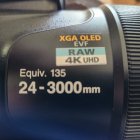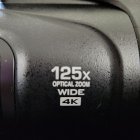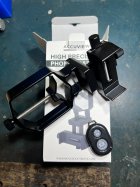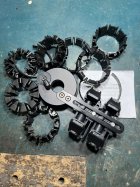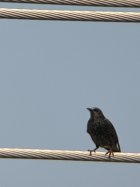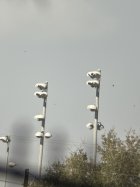It's has a smaller sensor about half the size of a 35mm, so the equivalent is about 125x. In addition it has a 4x digital zoom which is about worthless, but it is a cute little camera. I bought my wife one years ago and she uses it as a point and shoot. It's really not a bad consumer camera.Yeah, that does sound like the Nikon Coolpix P1000. It has a 125X zoom, but that goes from 24mm to 3000mm 35mm equivalent. This makes the largest magnification about 60X.
You are using an out of date browser. It may not display this or other websites correctly.
You should upgrade or use an alternative browser.
You should upgrade or use an alternative browser.
Cell phone spotting scope adapters
- Thread starter LeadHead
- Start date
Yeah, that's mostly wrong, but you are on the right track.It's has a smaller sensor about half the size of a 35mm, so the equivalent is about 125x. In addition it has a 4x digital zoom which is about worthless, but it is a cute little camera. I bought my wife one years ago and she uses it as a point and shoot. It's really not a bad consumer camera.
The Nikon Coolpix P1000 has a sensor called a 1/2.3". It's kind of a goofy name because it's not intuitively obvious. The actual lens on the camera is a 4.3-539 F2.8-8.0. When I said that the lens was a 24-3000mm 35mm equivalent, I said that for a reason, which I'll explain in a moment.
The 125X zoom is a marketing device to fool people by using the truth, but not the complete truth. If you divide 539 by 4.3 you will get 125.34 or 125. That's the 125X zoom. It goes from 4.3mm to 539mm, 125X. Now, if the lens is set at 4.3mm and that represents 1.0 magnification, ie a standard lens, then yes, when the lens is set at its maximum 539mm that would be 125 magnification. But that's not the case as 4.3mm is a wide-angle setting, I believe it's 0.5 magnification.
In the photography world, the 35mm format was the most widespread format in cameras until the digital revolution. Now I suspect the most widespread format is whatever sensor is in a Galaxy or iPhone, and those sensors are small.
The 35mm format was so firmly entrenched that it's much easier for photographers to relate to it and that for marketing purposes, it makes everything bigger. Also, in America, the metric system still fools people.
For instance, a 3000mm lens is about 10 feet long in reality, unless you fold it, at which point it would be quite wide. I don't know about you, but a 10-foot lens is more than I can handle or carry for any length of time. That's the size of the lens that is needed to present an image that will cover the 35mm film format.
You were right in saying that the sensor in the P1000 is smaller than a 35mm sensors, so the lens doesn't have to be 10 feet long to have that effective magnification.
But you were way off in the size, and this is where it gets fun.
The 35mm format has a sensor size of 36mmX24mm, 43mm in diagonal and covers 864 square mm. Its aspect ratio is 3:2.
The APS-C in my Nikon D7500 has sensor size of 23.5mmX15.6mm, 28mm in diagonal and covers 367 square mm. It also has an aspect ratio of 3:2. And because it's smaller than the 35mm format its focal length factor is 1.5. In other words, it gets a 1.5X boost in magnification compared to the 35mm format for the same focal length. So, a 200mm lens effectively becomes a 300mm lens with the APS-C sensor.
So, what is this 1/2.3" sensor in the P1000? Its size is 6.1mmX4.6mm, 7.7mm in diagonal. It covers 28 square mm. Its aspect ratio is 4:3 and that's why the pictures look squarer. But what of its focal length factor? It's 5.6. This means a 539mm lens is effectively 3000mm lens in 35mm parlance. But in fact, the lens is about a half meter (somewhat over 1.5 feet) long instead of 3 meters (10 feet). It's still a big-ash lens.
I mentioned magnification but just in passing. The magnification factor of a lens depends on the sensor size as well and the focal length. In 35mm parlance, the so-called standard lens, the one that produces a picture with no magnification, is a 50mm lens or thereabouts. So, for me, it's easy to figure out the magnification factor of a lens, I divide by 50. So, 3000mm is magnification 60. The bottom end is 24mm, so that magnification is 0.5. The lens goes from 0.5 magnification to 60 magnification, this represents a zoom factor of 120X (125 without the rounding in the various calculation.)
The standard lens for a 1/2.3" sensor would be something like 8.9mm or thereabouts. So, the 4.3mm is the 0.5 wide angle and 539mm represents about 60 magnification for a total zoom range of about 125x.
NOTE: I really watered-down various concepts here to present them in a way that people who are not into optics can understand and most importantly, can relate to. It's not a scholarly paper, I can tell you that.
TL;DR: The sensor in the P1000 is MUCH smaller than a 35mm format or APS-C format. This makes the "short" 539mm telephoto act like a 3000mm (10-foot) lens. The zoom range goes from wide angle (0.5X) to super telephoto (60X) and that makes up the 125X zoom range. 125X is NOT the magnification.
Yep, it's a NikonyIs that a Sony or a Nikon?
Attachments
Nice. Notice the sly dogs at Nikon snuck in the "Equiv. 135" above 24-3000mm. 135 is the same as 35mm format or 36X24.
It's still a big lens when deployed to max.
It's still a big lens when deployed to max.
Can't go wrong. Another are forgetting about the eye piece adapter.Take a look at Ollin -
Novagrade are very solid and universal.

 novagrade.com
novagrade.com

Novagrade - Digiscoping Perfected
Novagrade offers the most versatile digiscoping adapter available! Connect almost any phone with the case on to nearly any binocular, spotting scope, telescope or round ocular optics!
I have a Ricoh/Pentax 80mmED with zoom eyepiece and a wide angle fixed eyepiece. I use a iPhone 13ProMax. Have tried all the plastic adapters and are too flimsy to use reliably. The Accuview from China has been the best of this type as all aluminum construction , fits the large iPhone and very large Pentax eyepieces. Recently purchased the Novagrade adapter but it was not quite large enough to fit the Pentax eyepieces. About 1/8” too small. As the Pentax uses standard astronomical 1-1/4” eyepieces I purchased a low cost import of same focal length as Pentax but much smaller outer diameter. Had to purchase from Novagrade the small eyepiece adapter set to use the setup. The Novagrade is the most stable of all. Photo of stadium lights about 1/2 mile away and a bird on power line about 150 yds away. These things are not the easiest to use and a solid mount is needed.
The Accuview comes with remote shutter release for both Android and IPhones which makes things easier. Have a lot of time and money in trying all these things and none are what I would consider easy.
I would really like to see a good camera that could attach to eyepiece or better fit in my case standard 1-1/4” eyepiece scope but ones out there are for astronomy use and connect to computer or tablet.
The Accuview comes with remote shutter release for both Android and IPhones which makes things easier. Have a lot of time and money in trying all these things and none are what I would consider easy.
I would really like to see a good camera that could attach to eyepiece or better fit in my case standard 1-1/4” eyepiece scope but ones out there are for astronomy use and connect to computer or tablet.
Attachments
Similar threads
- Replies
- 5
- Views
- 875
- Replies
- 2
- Views
- 151
- Replies
- 5
- Views
- 2,487
Upgrades & Donations
This Forum's expenses are primarily paid by member contributions. You can upgrade your Forum membership in seconds. Gold and Silver members get unlimited FREE classifieds for one year. Gold members can upload custom avatars.

Click Upgrade Membership Button ABOVE to get Gold or Silver Status.
You can also donate any amount, large or small, with the button below. Include your Forum Name in the PayPal Notes field.
To DONATE by CHECK, or make a recurring donation, CLICK HERE to learn how.

Click Upgrade Membership Button ABOVE to get Gold or Silver Status.
You can also donate any amount, large or small, with the button below. Include your Forum Name in the PayPal Notes field.
To DONATE by CHECK, or make a recurring donation, CLICK HERE to learn how.










